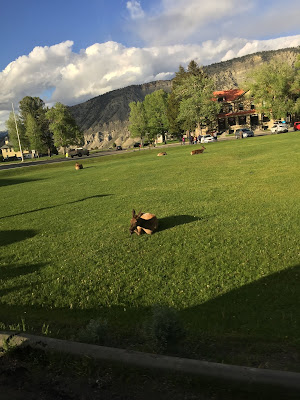Expanding Wildlife and Brucellosis
Post by Clemson undergraduate John Anderson
Wildlife, primarily including elk and
bison expanding their range, interacting with domesticated cattle has created
much concern for human management of the wildlife. This week our Great Plains landscape
consisted of the Yellowstone National Park and the surrounding Greater
Yellowstone Area. This defined area is a
working conservation landscape because there are different parties trying to
get the most out of the land in either ranching or in terms of wildlife, both
being able to sustain the land’s value into the future.
The people of the Greater Yellowstone Area
are trying to conserve the landscape in two different ways. The traditional ranchers are trying to
conserve their livelihood by continuing to use the grasses to effectively
raise and sell cattle. Another way
conservation is taking place in this area, is the need to conserve
wildlife. Yellowstone National Park is a
great reservoir for wildlife to live in, but with increasing populations,
predator/prey relations, and limited land area, wildlife is expanding its range outside the park boundaries and into neighboring lands including many
cattle ranches. Conservationists are
moving with the wildlife, lobbying for conservation in the outside areas causing
conflict with the ranchers.
In the past, animals and weather
influenced this landscape. Roaming bison
would migrate depending on the time of the year relating to the weather and
in turn the first inhabitants of this land, the Native Americans, would follow
the migrating bison. Once the Native
Americans were forced onto reservations by the United States government, land
was given to the homesteaders moving west to farm. After struggling to farm in this freezing,
dry climate, large cattle operations took over the landscape outside of
Yellowstone. In the present day,
traditional cattle ranching has decreased in popularity while conservation
efforts and hobby landowners are increasing in popularity. After meeting with a traditional rancher, state
senator, and field biologists, I believe that the wealthy, part-time ranch
residents and the conservation groups/organizations will squeeze out the last
of the full-time ranchers in the near future.
In talking with the long-time rancher, I now better understand the
difficulty of raising calves each year to make a living. Now with wildlife encroaching onto their
lands, new conservation policies, and added stress to sell out, it is a miracle
the Yellowstone Area ranchers are still around today producing food for
Americans. These variables are not a recipe
for success; therefore, I predict there will be fewer and fewer traditional
cattle ranchers each year in the Greater Yellowstone Area. The wealthy vacationers and big business
organizations like the American Prairie Reserve will gladly buy the land from
them.
The main conflict affecting the Greater
Yellowstone Area and leading to my prediction is the fear of Brucellosis. If brucellosis, from the Yellowstone elk and
bison, is detected in a nearby rancher’s herd, that rancher’s operation is
shutdown for months and additional testing costs are piled up all while they
most likely will have no calves to sell that year. This added pressure on the ranchers brings
much concern to them over the expanding wildlife. In turn to that, they fight, fight, and keep fighting
laws and policies concerning the conservation of wildlife. After talking to the rancher, in my opinion,
this fight is a losing battle as the other side has more money and their lively
hood is not on the line. Living in the
fear of brucellosis, I think is enough to end the cattle ranching industry in
the Greater Yellowstone Area.
After visiting the Greater Yellowstone
Area, I feel like I have been introduced to, included in, and a part of the
Brucellosis conflict and the ranching, wildlife relations. With that involvement comes responsibility
that I hope to act on and further educated myself about.



